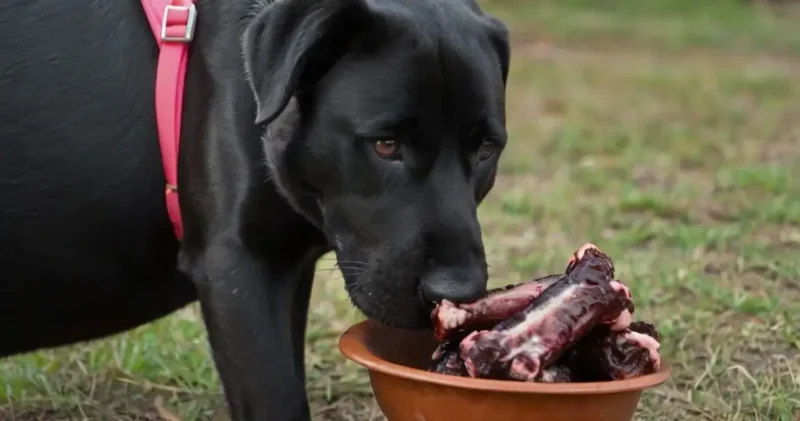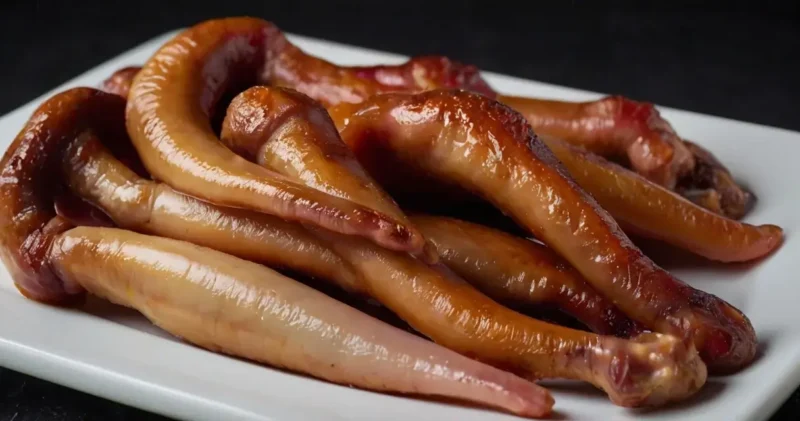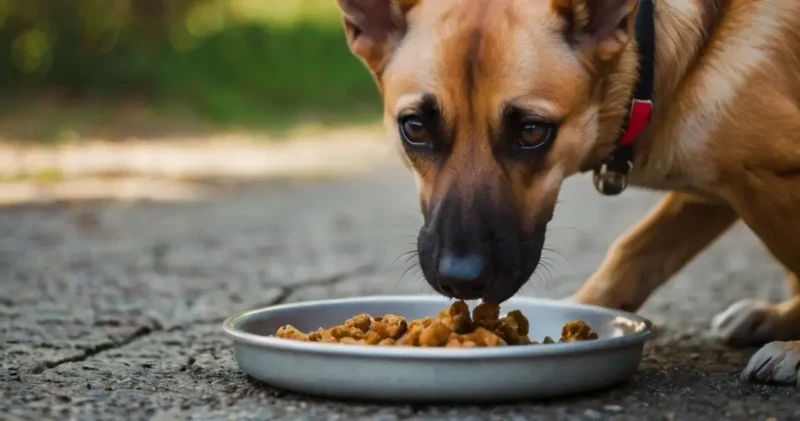Many pet owners often wonder whether it’s safe to feed their dogs pig feet. This article aims to provide a detailed answer to this commonly asked question, “Can Dogs Eat Pig Feet?” covering various aspects of feeding pig feet to dogs, including nutritional value, health benefits, potential risks, preparation methods, and alternative options.
Can Dogs Eat Raw Pig Feet?
Let me explain first what are raw pig feet. Raw pig feet commonly referred as pork trotters are the feet of a pig. They are composed of:
- Skin
- Fat
- Connective tissue
- Bones
The connective tissue is based on tendons, ligaments and cartilage. This tissue is famous for its collagen content which gives it a gelatinous texture while cooking. However, it is important to clean and boil them before feeding to your pet. A 100g of raw pig foot contains:

- 107mg cholesterol
- 22g protein
- 16g fat
Its easy to find pig’s feet at local butcher shops and meat section in supermarkets. The way of presenting can differ since people belonging to different races prefer having them in different forms.
It’s important to note that pig’s feet are popular in various cuisines around the world. People in United States and China consume it in more quantity.
Can Dogs Eat Pig Feet?
Pig trotters, which are pig feet, can be a safe and enjoyable treat for dogs when they are prepared and given to them correctly. Dogs love pig trotters because they can chew on them, which keeps them busy and happy. This is better than them chewing on your shoes! Chewing on pig trotters is like a fun game for them.
Pig trotters contain:
- Iron
- Zinc
- Protein
- Vitamin b12
in simple words, pig trotters can be a great treat for dogs and provide some health benefits when given in the right way. However, it triggers many health risks which may overcome its advantages.
What are Health Risks of Feeding Pig Trotters to Dogs?
Are their some health risks of feeding your dog with pig trotters or are they only myths? Many of you might be wondering “Are pig feet bad for dogs?” There are number of health issues triggered due to feeding dogs with pig potter. From dental department to obesity and digestive issues, it threatens each and every body organ. Here are some commonly reported health risks mentioned:
- Choking Hazard: Pig trotters are hard bones that can break into small pieces. If your dog tries to swallow big chunks, they might choke on them.
- Stomach Troubles: Pig trotters have lots of fat, which can upset some dogs’ stomachs. This might lead to problems like tummy aches, diarrhea, or even a serious condition called pancreatitis.
- Bacteria Risk: Pig trotters can carry nasty bacteria like Salmonella. If you don’t handle or cook them the right way, both your dog and you could get sick.
- Weight Gain: Pig trotters are fatty, and too much fat can make your dog gain weight. This could lead to obesity, which isn’t healthy. You can click here to study health issues obese dogs suffer.
- Allergies: Some dogs can become allergic to certain proteins, and pork is a common one. So, feeding your dog pig trotters might trigger allergic reactions in some pups.
- Dental Issues: Chewing pig trotters can help keep your dog’s teeth cleaner, but if the bones are very hard or your dog chews too vigorously, they might break a tooth or have other dental issues.
Can Dogs Eat Smoked Pig Feet?
Feeding your dog with smoked pig trotters is not recommended by vets.
The spices and salt used in its marination can trigger several health issues in dogs. It can even lead to salt poisoning. Some commonly observed medical issues caused by feeding smoked pig feet to dogs are:
- Seizures
- Tremors
- Drooling
- Lethargy
- Excessive urination
- High blood pressure
- Diarrhea
A few weeks ago, my personal canine pet was suffering through diarrhea. Believe me, it was like living in a public washroom. In case you have fed him with smoky pig feet, please do not hesitate to take him to a vet.

Can Dogs Eat Cooked Pig Feet?
Yes, dogs can eat cooked pig’s feet, but there are important things to consider for your canine’s safety. When pig’s feet are cooked properly, they can be a tasty and nutritious treat for dogs.
It’s crucial to cook pig’s feet thoroughly to kill harmful bacteria and parasites. You should avoid feeding your dog raw or undercooked pig’s feet to prevent illnesses. Cooked pig’s feet can provide some health benefits for dogs. However, it’s essential to consider the fat content, as it can lead to fatness in dogs. Feeding it in excess may also trigger following health issues:
- Obesity
- Pancreatitis
- Bloating
- Lethargy
- Heart disease
- Diarrhea
- Vomiting
Cooked pig’s feet can be given to dogs as an occasional treat but do confirm the quantity you are serving should be moderate and your canine fellow should not be allergic to it. Always watch your dog when they’re eating them to prevent choking
How Long Should I Boil Pig Feet to Feed it to Dogs?
To make pig feet flavorful, it is essential to boil it in water. You should simmer the pig’s feet for about 30 minutes to an hour. Boiling for this period helps make the meat tender, making it easier for your dog to chew and digest.
Here I have found an excellent way for you to avoid any hassle
Put the pig’s feet in a pot with water, place the pot over flame and start boiling. Then turn down the heat to let it simmer. You can add some dog-friendly veggies like carrots to make it flavorful.
After they’re done cooking, let the pig’s feet cool down for a while before giving them to your dog. This prevents any burns or discomfort.
How to Feed Raw Pig Feet to Dogs?
| SR.NO | STEPS | |
|---|---|---|
| 1. | Feed in moderation | Feed your dog with pig feet in moderation. Feeding them in excess can trigger many health disasters. |
| 2. | Observe size of pig feet | They should be small in size so your dog could chew them easily. |
| 3. | Supervise your dog | Keep an eye on your dog to prevent any choking hazards. |
| 4. | Remove hair from surface | It is important to remove hairs to avoid any further inconvenience. Otherwise your dog might throw up while eating. |
| 5. | Clean pig feat | Gently rinse it water to remove all bacteria. |
| 6. | Boil pig trotters | Boil them for approximately 30 mins to make them soft. It is easy for dogs to chew soft pig feet. |
| 7. | Cook feat | Last stage is to cut the feet into smaller pieces and cook them. Don’t add any spices since they can cause irritation in your dog’s stomach. |
Follow the above-mentioned steps to feed your canine fellow with pig feet.
What to Combine With Raw Pig’s Feet to Make it a Complete Meal for Your Dog?
Creating a balanced diet plan comprising of all required nutrients for your canine is a difficult task. It is necessary to provide your dog with all required nutrients. Raw pig’s feet have lots of calories and fat, so it’s better to mix them with lean meat.
Including chicken liver or beef kidney is a good option to fulfill all vitamins and nutrition requirement of your dog. Although you can add spinach, carrots, and red beets too. These provide fiber, vitamins, and antioxidants. To know more about advantages of different meats for your canine, you can visit link.
It’s also important to consult with a veterinarian or pet nutritionist to alter the diet according to your dog’s needs, as each dog may have different dietary requirements.
How to Store Pig Feet?
There are different ways for storing raw pig feed and cooked pig feet. For your convenience, I have brough them under the same domain.

Raw Pig Feet:
To store raw pig’s feet for dogs, keep them in an airtight container in the freezer. Make sure they are well-sealed to prevent contamination. This helps in maintaining freshness and prevents bacterial growth. Raw pig’s feet should be handled safely to avoid health risks for your dog.
Cooked Pig Feet:
If you’re storing cooked pig’s feet for your dog, place them in an airtight container in the refrigerator for up to three to four days. To store them for a longer period, freeze them in sealed bags or containers. Always reheat thoroughly before serving to eliminate any harmful bacteria. Proper storage and reheating ensure your dog’s safety when enjoying cooked pig’s feet as a treat.
You can click here to learn methods of preserving meat.
https://www.ndvsu.org/images/StudyMaterials/VPH/methods_of_preservation_of_meat.pdf
Alternatives to Pig Feet for Dogs
Its not essential to feed your dog with pig feet. There are many better alternatives to pig feet for dogs. Here they are listed:
- Chicken liver is something rich in iron and vitamin A. It can be used as an alternative to pig feet.
- Beef kidney is another good source of vitamins and minerals for your dog’s diet.
- Turkey gizzard is low in fat and rich in proteins. It can be the best alternative to pig feet.
- Salmon is rich in omega-3 fatty acids, which are excellent for your dog’s skin and coat health
- Sardines are a small, oily fish that can be a healthy addition to your dog’s diet. They offer omega-3 fatty acids.
What Part of Pig is Good for Dogs?
Here are few parts of pig good for your dog:
- Pork Liver: Rich in vitamins and minerals such as vitamin A, iron, and B vitamins, pork liver can be a nutritious addition to a dog’s diet when fed in moderation.
- Pork Heart: A lean source of protein and essential amino acids, pork heart can benefit a dog’s muscle health and overall well-being. It’s important to trim away any excess fat before feeding.
- Pork Kidney: While relatively high in purines and should be given in moderation, pork kidney can provide dogs with essential nutrients like vitamin B12 and selenium.
- Pork Ears: A popular chew treat for dogs, pork ears can help satisfy their natural urge to chew while also providing dental benefits by promoting healthy teeth and gums. However, they should be fed in moderation to prevent obesity.
- Lean Cuts Of Pork: Lean cuts of cooked pork such as pork loin or pork tenderloin can be suitable for dogs, as they are rich in protein and can provide essential nutrients.
It’s important to ensure that the pork is thoroughly cooked and free from any seasonings or additives that may be harmful to dogs, such as garlic or onion powder. Additionally, bones should be avoided as they can pose a choking hazard or cause intestinal blockages. As with any new food, it’s best to introduce pork to your dog’s diet gradually and monitor for any signs of digestive upset or allergies.\
Regulatory Conditions
When it comes to the production and sale of pig feet for pet consumption, there are several regulations and guidelines in place to ensure quality and safety standards are met. These regulations may vary depending on the country or region, but they generally aim to protect the health and well-being of both pets and consumers.
- Ingredients and Labeling: Regulations may require pet food manufacturers to accurately list all ingredients used in their products, including pig feet. This ensures that consumers are aware of what they are feeding their pets and can make informed decisions based on their dietary needs and preferences.
- Quality Control: Regulations may stipulate standards for the quality and safety of pig feet used in pet food production. This may include requirements for sourcing from approved suppliers, proper handling and storage procedures, and regular inspections to prevent contamination or spoilage.
- Nutritional Requirements: Regulatory agencies may establish minimum nutritional requirements for pet food products, including those containing pig feet. This ensures that pet foods provide essential nutrients necessary for the health and well-being of dogs, helping to prevent nutritional deficiencies and promote overall health.
- Health and Safety Standards: Regulations may mandate adherence to specific health and safety standards throughout the production process, from slaughter and processing to packaging and distribution. This helps minimize the risk of foodborne illnesses and ensures that pet food products are safe for consumption by dogs.
- Label Claims and Marketing: Regulations may govern the use of label claims and marketing tactics used by pet food manufacturers to promote their products. This helps prevent misleading or false advertising and ensures that consumers can trust the information provided on pet food labels.
Conclusion
To conclude, I would recommend you to opt any meal from the discussed alternatives. These meals lessen the risks offered with use of pig feet, making them a good alternative. However, the decision is still yours.
FREQUENTLY ASKED QUESTIONS
Furthermore, pig feet are rich in fat that can be harmful for your dog. You can also find a number of articles on suggesting you proper meals for cats and dogs on this website. Here are inks for a few:
Can dogs eat tapioca? 4 secret benefits






4 thoughts on “Uncovering a Mystery: Can Dogs Eat Pig Feet? 5 reasons”